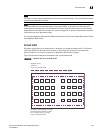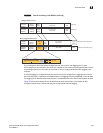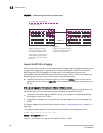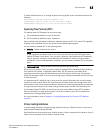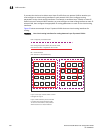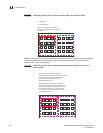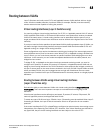
PowerConnect B-Series FCX Configuration Guide 441
53-1002266-01
VLAN overview
13
Static ports
Static ports are permanent members of the protocol VLAN. The ports remain active members of
the VLAN regardless of whether the ports receive traffic for the VLAN protocol. You must explicitly
identify the port as a static port when you add it to the VLAN. Otherwise, the port is dynamic and is
subject to aging out.
Excluded ports
If you want to prevent a port in a port-based VLAN from ever becoming a member of a protocol, IP
subnet, IPX network, or AppleTalk cable VLAN configured in the port-based VLAN, you can explicitly
exclude the port. You exclude the port when you configure the protocol, IP subnet, IPX network, or
AppleTalk cable VLAN.
Excluded ports do not leak broadcast packets. Refer to “Broadcast leaks” on page 441.
Broadcast leaks
A dynamic port becomes a member of a Layer 3 protocol VLAN when traffic from the VLAN's
protocol is received on the port. After this point, the port remains an active member of the protocol
VLAN, unless the port does not receive traffic from the VLAN's protocol for 20 minutes. If the port
does not receive traffic for the VLAN's protocol for 20 minutes, the port ages out and is no longer
an active member of the VLAN.
To enable a host that has been silent for awhile to send and receive packets, the dynamic ports
that are currently members of the Layer 3 protocol VLAN "leak" Layer 3 broadcast packets to the
ports that have aged out. When a host connected to one of the aged out ports responds to a leaked
broadcast, the port is added to the protocol VLAN again.
To "leak" Layer 3 broadcast traffic, an active port sends 1/8th of the Layer 3 broadcast traffic to the
inactive (aged out) ports.
Static ports do not age out and do not leak broadcast packets.
Super aggregated VLANs
Dell PowerConnect devices support Super Aggregated VLANs. You can aggregate multiple VLANs
within another VLAN. This feature allows you to construct Layer 2 paths and channels. This feature
is particularly useful for Virtual Private Network (VPN) applications in which you need to provide a
private, dedicated Ethernet connection for an individual client to transparently reach its subnet
across multiple networks.
For an application example and configuration information, refer to “Configuring super aggregated
VLANs” on page 477.
Trunk group ports and VLAN membership
A trunk group is a set of physical ports that are configured to act as a single physical interface.
Each trunk group port configuration is based on the configuration of the lead port, which is the
lowest numbered port in the group.
If you add a trunk group lead port to a VLAN, all of the ports in the trunk group become members of
that VLAN.



